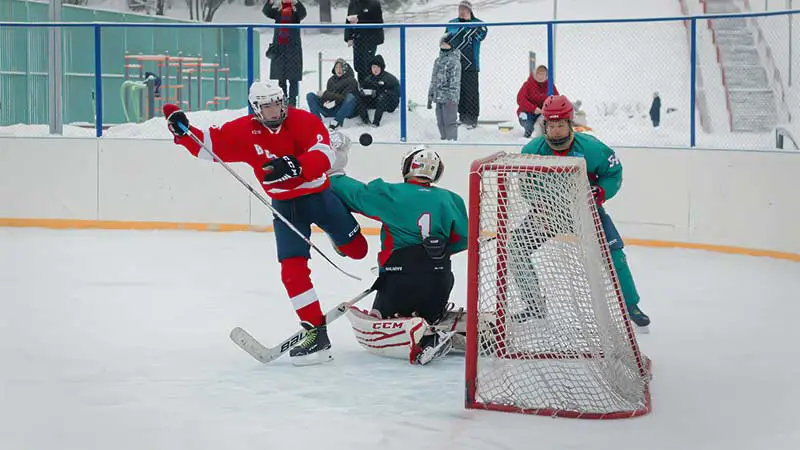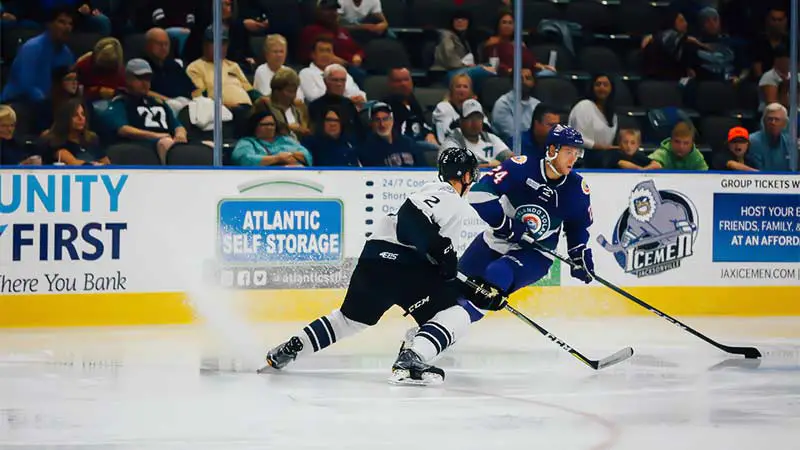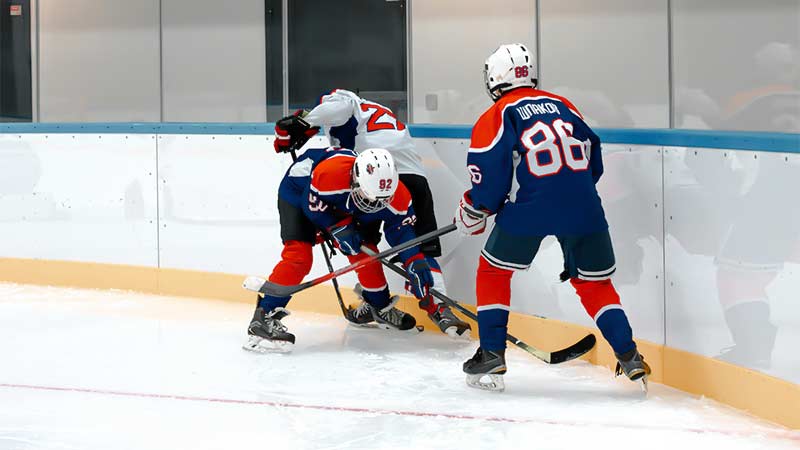Body checking in hockey is a fundamental defensive technique that allows players to gain control of the puck by using their body to legally separate opponents from the puck.
This physical move involves the deliberate use of torso, hips, and shoulders to block or stop another player, with the impact ranging from a gentle nudge to a full-body hit.
However, the legality of body checking is subject to specific rules and regulations, especially concerning player safety.
In ice hockey, the allowance of body checking varies depending on factors such as player age, skill level, and the rules of the league or organization.
While body checking is a strategic tactic to gain possession of the puck, it also raises safety concerns due to the potential for injuries.
Understanding the proper techniques and regulations surrounding body checking is crucial for players to effectively navigate the physical aspects of the game while prioritizing safety on the ice.
Understanding Body Checking in Hockey
The Role of Body Checking in the Game
Body checking in ice hockey is a key defensive tactic used to gain control of the puck by legally separating opponents through physical contact with the hips, shoulders, and torso.
The main goal is to dispossess the opponent of the puck rather than intimidate or harm them, highlighting the importance of mastering this skill to ensure player safety during matches.
The Evolution of Body Checking Rules
The rules on body checking in hockey have evolved to prioritize player safety, with lateral or blindside hits to an opponent’s head being deemed illegal since the 2010-11 NHL season, resulting in severe penalties like major penalties and game misconducts.
Subsequent seasons introduced stricter penalties for head-targeting hits, focusing on penalizing avoidable contact to the head to reduce injuries and enhance player safety.
Adhering to these regulations can create a safer and more respectful environment in hockey, fostering fair play and sportsmanship among players, coaches, parents, and officials.
Types of Legal Body Checks

Hip Check
In ice hockey, a hip check is a legal body checking technique where a player bends down and leads with the hip into the opponent carrying the puck. It is a highly effective move when executed correctly with a low risk of injury, making it a valuable defensive tactic.
Shoulder Check
The shoulder check is one of the most commonly used legal body checks in hockey. In this technique, a player leads with the shoulder when making contact with an opponent.
It is crucial for the delivering player to keep the elbow tucked in to avoid penalties, especially if the elbow comes close to the opponent’s head.
Stick Check
Using the stick to lift or poke at an opponent’s stick is known as a stick check in hockey. This move is effective in disrupting the opponent’s play while posing a low risk of injury. Stick checks are a key part of defensive strategies to gain possession of the puck legally.
Common Illegal Body Checking Penalties

Boarding and Charging
In hockey, boarding is when a defenseless player is forcefully hit into the boards, leading to possible head or face injuries.
Charging occurs when a player aggressively checks an opponent after covering a significant distance.
These penalties are considered dangerous and can result in minor two-minute penalties or more severe consequences like game misconducts due to the risk of causing serious harm.
Cross-Checking and Checking from Behind
Cross-checking in hockey involves a player using their stick with both hands to hit an opponent during a check, resulting in penalties due to the potential for severe injuries.
Checking from behind is also prohibited as it poses risks to player safety, with direct or diagonal body checks from behind being forbidden.
Head Contact and Roughing
In hockey, head contact is a major issue, and strict penalties are enforced to safeguard players. Illegal hits directed at the head or causing head contact lead to severe repercussions, while roughing penalties are given for aggressive behavior not in line with fair play rules.
Players must steer clear of head contact and roughing violations to uphold a safe and competitive atmosphere during games.
The Art of Body Checking
Continuing from the discussion on legal and illegal body checking techniques in hockey, it is vital for players to master the art of body checking to ensure both effective gameplay and player safety.
Here, we delve into key aspects that play a crucial role in executing successful body checks in hockey.
Technique and Timing
Executing a body check requires impeccable technique and precise timing. Players must ensure that their checks are performed legally, focusing on separation from the puck or gaining puck possession.
It is essential to emphasize proper body positioning, angling, and timing to deliver a successful body check without risking penalties or causing injury to opponents.
Reading the Play and Anticipating Moves
Effective body checking relies on the skill of reading the game and predicting opponents’ actions.
Understanding the game dynamics and players’ behaviors helps in positioning for successful checks. Anticipation is key to making timely and impactful decisions when executing body checks during gameplay.
The Importance of Follow-Through
Follow-through is crucial in mastering body checking in hockey. Players need to stay focused and alert after delivering a check, ready to respond to the play’s next moves.
This involves swiftly recovering, repositioning, and being prepared for defensive or offensive actions based on the check’s outcome.
Emphasizing follow-through can improve players’ effectiveness in body checking and benefit their team’s performance.
Safety in Body Checking
The safety aspects of body checking in hockey are crucial to prevent injuries and ensure a fair play environment on the ice.
Understanding and following safety guidelines can significantly reduce the risks associated with body checking techniques, promoting a safer and more enjoyable game for all players involved.
Age Considerations for Body Checking
Age considerations are crucial in the context of body checking in hockey to protect players’ well-being.
Younger and less skilled players, especially at grassroots levels, may not have the necessary physical development or proficiency for safe full-body checking.
Coaches and hockey associations should set age restrictions and guidelines to introduce body checking appropriately, reducing the risk of injuries among young athletes.
Protective Gear and Injury Prevention
Equipping players with the proper protective gear is fundamental in injury prevention during body checking in hockey.
Helmets, shoulder and elbow pads, mouthguards, jockstraps, gloves, shin guards, and pants are essential pieces of equipment that can significantly reduce the risk of injuries during physical play on the ice.
Ensuring that players wear and maintain their protective gear properly is key to safeguarding against potential injuries and enhancing overall player safety during body checking maneuvers.
The Debate Over Body Checking
Body Checking in Youth Hockey
In youth hockey, the debate over body checking revolves around the potential risks of injuries associated with this physical aspect of the game.
While body checking is a legal defensive move in hockey, concerns have been raised regarding the safety of young players, especially those under the age of 12.
National hockey associations in Canada and the United States have taken proactive steps to ban body checking for younger players, with some parents supporting the ban to minimize injury risks.
Body Checking in Women’s Hockey
Women’s hockey has its own set of rules concerning body checking, with specific considerations for safety and fair play. In women’s IIHF ice hockey, body checking is considered an illegal hit, and penalties are imposed for reckless body checking.
While body checking was allowed at the first women’s world ice hockey championship in 1990, it has since been deemed illegal in many leagues to prioritize player safety and prevent unnecessary injuries.
Frequently Asked Questions
What are some common legal body checking techniques in hockey for defensive purposes?
Legal body checking techniques in hockey include the hip check, shoulder check, and stick check. These techniques are used strategically to gain possession of the puck or disrupt opponents’ plays without causing penalties.
What are the risks associated with illegal body checking in hockey?
Illegal body checking in hockey comes with serious risks, including potential injuries to both the player delivering the check and the one receiving it. Common injuries resulting from illegal body checking include concussions, neck injuries, and fractures.
How can players master the art of body checking in hockey?
To master body checking in hockey, players need to focus on proper technique, timing, reading the play, and anticipating opponents’ moves. Follow-through is crucial for executing successful body checks while maintaining safety and fairness on the ice.
Why is following safety guidelines important when body checking in hockey?
Following safety guidelines during body checking in hockey is crucial to prevent injuries and ensure fair play. Proper technique and adherence to rules help minimize the risk of serious harm to players and promote a safer playing environment overall.
What are age considerations for introducing body checking in hockey?
Introducing body checking in hockey should be age-appropriate to prevent injuries among young players. It is essential to consider the physical development and skill level of players before allowing body checking to ensure their safety and well-being on the ice.
Conclusion
Mastering legal body checking techniques in hockey is essential for players to enhance their defensive skills and contribute effectively to their teams.
Understanding the nuances of body checking, from technique to timing, is crucial in executing successful plays while minimizing injury risks.
Safety remains paramount, with adherence to guidelines and age-appropriate introduction of body checking practices vital for player well-being.
The debate surrounding body checking in youth and women’s hockey reflects a growing emphasis on safety and fair play, prompting regulatory changes to protect players at all levels.
By prioritizing proper technique, safety measures, and protective gear, players can engage in body checking responsibly, fostering a competitive yet secure environment on the ice.








James Felix